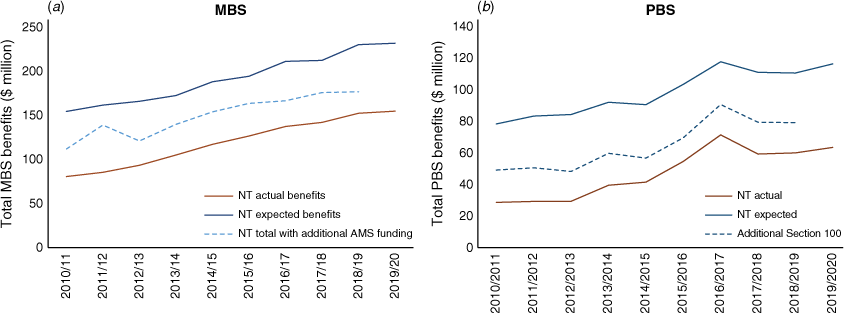Remoteness, models of primary care and inequity: Medicare under-expenditure in the Northern Territory
Yuejen Zhao A B , John Wakerman B , Xiaohua Zhang A , Jo Wright A , Maja VanBruggen A , Rus Nasir A , Stephen Duckett C and Paul Burgess A *A Department of Health, Manunda Place, 38 Cavenagh Street, Darwin, NT 0811, Australia.
B Menzies School of Health Research, NT, Australia.
C Grattan Institute, Melbourne, Vic., Australia.
Australian Health Review 46(3) 302-308 https://doi.org/10.1071/AH21276
Submitted: 26 August 2021 Accepted: 22 February 2022 Published: 5 May 2022
© 2022 The Author(s) (or their employer(s)). Published by CSIRO Publishing on behalf of AHHA. This is an open access article distributed under the Creative Commons Attribution-NonCommercial-NoDerivatives 4.0 International License (CC BY-NC-ND)
Abstract
Objective To analyse Medicare expenditure by State/Territory, remoteness, and Indigenous demography to assess funding equality in meeting the health needs of remote Indigenous populations in the Northern Territory.
Methods Analytic descriptions of Medicare online reports on services and benefits by key demographic variables linked with Australian Bureau of Statistics data on remoteness and Indigenous population proportion. The Northern Territory Indigenous and non-Indigenous populations were compared with the Australian average between the 2010/2011 and 2019/2020 fiscal years in terms of standardised rates of Medicare services and benefits. These were further analysed using ordinary least squares, simultaneous equations and multilevel models.
Results In per capita terms, the Northern Territory receives around 30% less Medicare funds than the national average, even when additional Commonwealth funding for Aboriginal medical services is included. This funding shortfall amounts to approximately AU$80 million annually across both the Medicare Benefits Schedule and Pharmaceutical Benefits Scheme. The multilevel models indicate that providing healthcare for an Aboriginal and Torres Strait Islander person in a remote area involves a Medicare shortfall of AU$531–AU$1041 less Medicare Benefits Schedule benefits per annum compared with a non-Indigenous person in an urban area. Indigenous population proportion, together with remoteness, explained 51% of the funding variation. An age–sex based capitation funding model would correct about 87% of the Northern Territory primary care funding inequality.
Conclusions The current Medicare funding scheme systematically disadvantages the Northern Territory. A needs-based funding model is required that does not penalise the Northern Territory population based on the remote primary health care service model.
Keywords: chronic disease management, epidemiology, equity, health economics, health funding and financing, indigenous health, primary health care, rural and remote health.
Introduction
Medicare is Australia’s universal health insurance scheme, implemented in 1984 and operationalised through the Medicare Benefits Schedule (MBS) and Pharmaceutical Benefits Scheme (PBS).1 84% of the costs of primary (unreferred) medical care are met by the Commonwealth Government, involving only 6% of individual out-of-pocket payment for visits to general practitioners (GPs).2 However, beyond well-resourced urban populations, Medicare access is not universal because of medical and allied health practitioner shortages in remote and regional Australia and the inflexibility to reimburse alternate primary health care (PHC) service models. Consequently, access to PHC becomes restricted. Unlike major cities in Australia, a remote clinic managed by an Aboriginal medical service or Northern Territory (NT) Government is, in most cases, the sole service provider in the community, covering all aspects of healthcare delivery. Services range from health promotion, preventative care (such as vaccinations for COVID-19), PHC, dental care, pharmacy, acute and emergency care, rehabilitation and palliative care. Throughout Australia, remote and regional residents rely more heavily on retrievals and hospital services for PHC and, when admitted, are generally sicker and require longer hospitalisation.3 The NT is uniquely exposed to these risks. The NT population of 228 800 (2016 census) is dispersed over 1.4 million square km4 without a large urban population centre to buffer health financing risks. In 2016, First Nations Aboriginal and/or Torres Strait Islander peoples (hereafter respectfully referred to as Indigenous peoples) constituted 30% of the total NT population, of whom 77% lived in remote and very remote areas. The proportions of the Indigenous population and remoteness are intertwined with inadequate access to Medicare. The Commonwealth Government introduced Aboriginal health service payments and the Section 100 subsidised medicines program for remote Indigenous populations to handle this inadequacy.5 But this inadequacy persists after additional Indigenous medical services funding is included. In 2018/2019, the NT health expenditure for referred and unreferred medical services, including Aboriginal medical services, was AU$718 per person, the lowest of all jurisdictions and 24% below the Australian average (AU$942 per person).2 Capitation has been strongly recommended by the World Health Organization and the Organisation for Economic Co-operation and Development for funding PHC to counter the disadvantage of the fee-for-service payment for better health equity and quality of care.6
Our objectives were to analyse NT Medicare utilisation compared to the national average and investigate the correlation between Medicare expenditure and Indigenous demographic variables and remoteness. We hypothesised that the Indigenous demography plays a significant role in explaining the lower Medicare utilisation, and a simple demographic capitation model could largely rectify this primary care funding inequality.
Methods
MBS and PBS utilisation data were extracted from the online databases provided by Services Australia between the 2010/2011 and 2019/2020 financial years.7 Age, sex, State/Territory (state) and professional category were used to analyse MBS/PBS services, benefits and per-capita averages. Additional funding for Indigenous medical expenditure (including Aboriginal medical services and NT Government PHC services) was estimated by using the difference between the NT medical expenditure in the Australian Institute of Health and Welfare (AIHW) health expenditure reports2 minus NT MBS benefits. PBS Section 100 data were sourced from the Commonwealth Department of Health.8 Indigenous population estimates by year, age and sex were sourced from the Australian Bureau of Statistics (ABS).9 The NT has the highest Indigenous population proportion in Australia, at around 30%.10 To provide a simple measure for remoteness linked with annual demographic changes, remoteness was measured using a population density measure, reflecting the relative scale of travel cost differentials derived from area and population size.11,12 State-level remoteness ranged from the least remote Victoria (52), New South Wales and Australia Capital Territory (both 55), Queensland (61), Tasmania (66), South Australia (67), Western Australia (68) to the most remote NT (94) in 2016.
Direct and indirect age standardisations were used to assess the disparities between the NT and Australian averages in Medicare utilisation and eliminate the impact of age. Ordinary least squares (OLS), structural equations (SEM) and multilevel models were applied to determine the impact of Indigenous proportions and the interactions with remoteness on Medicare utilisation after controlling for age, sex and year.13
Ethics approval
This study was approved by the Human Research Ethics Committee of the NT Department of Health and Menzies School of Health Research (2020-3934).
Results
In 2019/2020, unadjusted per-capita MBS services in the NT were 11.9, the lowest of all states and nearly 30% below the national average (Table 1). Unadjusted per-capita MBS benefits in the NT were AU$648, the lowest of all states and 67% of the national average. Fig. 1 indicates that the NT per-capita MBS benefits were 11% (AU$109) and 84% (AU$804) of the national average (AU$959) for Indigenous and non-Indigenous populations, respectively with an overall shortfall of AU$312 per person (33%) in 2019/2020.
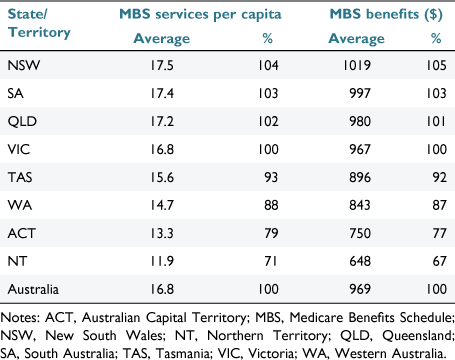
|
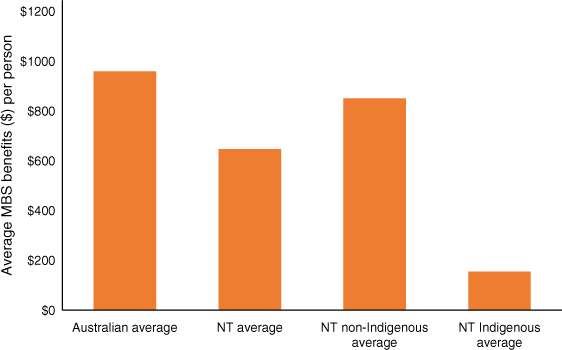
|
Time trend analysis shows that from 2010/2011 to 2017/2018, per-capita MBS services in the NT increased from 8.5 to 12.1 before declining to 11.9 in 2019/2020 (Supplementary Fig. S1a). The gap in per-capita MBS services between the NT and national average narrowed from 41% in 2010/2011 to 28% in 2017/2018 and then widened to 29% in 2019/2020. Per-capita MBS benefits in the NT increased from AU$382 in 2010/2011 to AU$648 in 2019/2020. The MBS benefit gap narrowed only marginally from AU$351 in 2010/2011 to AU$311 in 2017/2018 and then increased slightly to AU$322 in 2019/2020 (33% of the national average, Supplementary Fig. S1b). Throughout, the benefit gap was greater than the MBS activity gap.
With regard to the makeup of MBS services (see Fig. 2), the NT had relatively fewer specialist attendances (14% compared to 19% nationally), but relatively more GP attendances (30% vs 27% nationally) and pathology tests (37% vs 34%). Age-specific comparisons demonstrated that per-capita MBS benefits increased with advancing age except for the youngest group (0–4 years, Supplementary Fig. S2). NT residents accrued less MBS benefits than the average Australian in all age groups. The discrepancy increased with age from AU$76 (16.4%, AU$391 vs AU$467) perperson in the 0–4 age group to AU$911 (33.5%, AU$1805 vs AU$2715) in the 85+ years in 2019/2020. Age decomposition found that the younger age structure (unadjusted for morbidity) accounted for one-third (AU$102 or 32%) of the total NT gap (AU$322) in MBS benefits in 2019/2020. After age adjustments, the total NT funding shortfall between actual and expected benefits remained substantial between 2010/2011 and 2019/2020 (Fig. 3a). Commonwealth Government additional funding for Aboriginal medical services (dashed line in Fig. 3a) did not fill the gap.2 The funding shortfall was estimated to be around AU$50 million annually after adding the Aboriginal medical services funding.
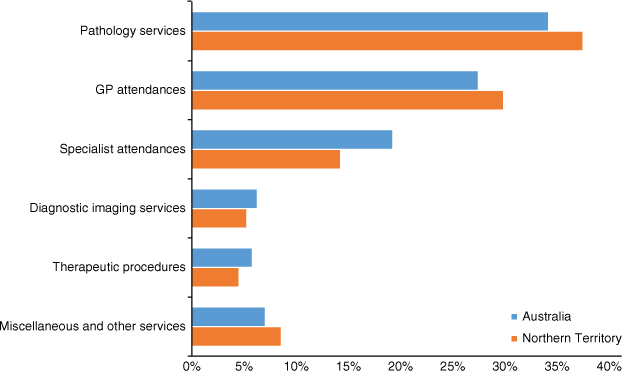
|
Due to the intercorrelations between age and MBS benefits and between Indigenous status and remote residence, OLS, SEM and multilevel models were used to explain the disparities in MBS utilisation. The final multilevel model revealed that an Indigenous person in a remote area accrued AU$531 less MBS benefits than a non-Indigenous person in an urban area (Supplementary Table S1), a ratio of 0.41 compared to the average (Supplementary Fig. S3). Indigenous proportions explained 51% of the total variation. Remoteness was masked in the final model because Indigenous proportions became a surrogate measure for both.
PBS data showed a similar story (Fig. 3b), indicating the NT population has poor access to PBS benefits. According to the national average, the NT PBS funding shortfall amounted to about AU$50 million annually without Section 100 and AU$30 million with Section 100 supplementation.
To overcome funding inequality, demographic and geographic capitation formulas were tested (Table 2). Capitation on age and sex contributed to a 29% increase in PHC funding, with further adjustment for Indigenous proportion and remoteness contributing 48% increase in PHC funding in the NT.
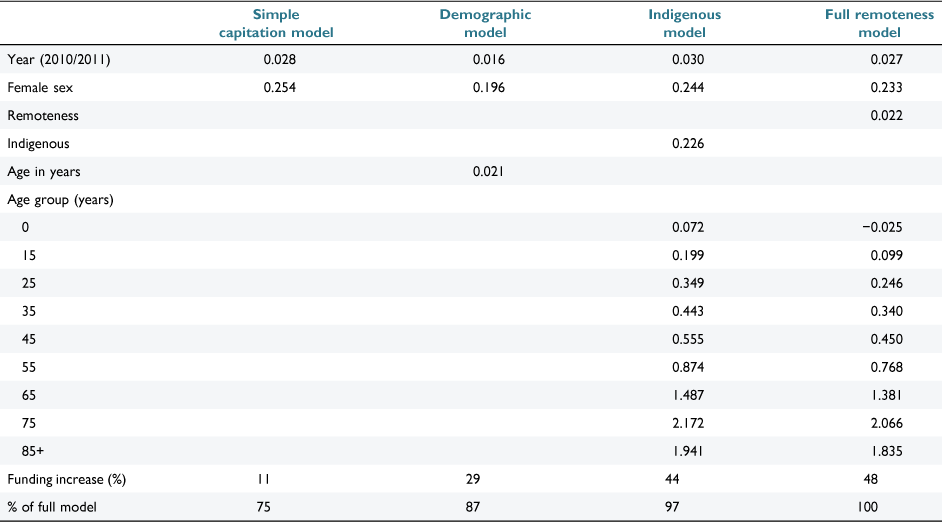
|
Discussion
The current Medicare system systematically disadvantages the NT. This study builds on previous findings14,15 that the NT receives the lowest per-capita payments from MBS and PBS, despite its greater remoteness and health needs.16,17 The AU$80 million combined shortfall is not an overestimate because adjustment is required to address the poor health status of the NT population. Stagnations in MBS activity between 2017/2018 and 2019/2020 are concerning as the burden of chronic disease continued to rise.17 Needs-based population funding is required to sustain PHC service delivery in remote Indigenous communities and improve health funding equality and population health outcomes.
However, this is not a problem limited to the NT. Australia-wide, remote Indigenous populations are socioeconomically disadvantaged subject to worse health outcomes.18 The mainstream model of PHC provision is general practice. Private GPs provide care on a fee-for-service basis under a demand-driven small business model. Remote PHC service delivery could not be more different. Remote PHC delivery is primarily led by Aboriginal Health Practitioners (AHP) and Remote Area Nurses who provide first contact care following standard treatment guidelines.19 A typical remote clinic in the NT consists of 3.4 nurses, 1.3 AHPs, 1 administrative position and 0.2 physical aids.20 Where necessary, backup phone support is available from an experienced medical officer (a remote area GP) or a medical retrievalist for more urgent cases. The majority of this PHC service activity, including those by AHPs and Remote Area Nurses, falls outside MBS eligibility criteria because it is not a face-to-face interaction (and more recently, video-conferenced consultation) with a GP. Added to this are the complexities of gaps in health literacy, language and cultural barriers to communication, transient workforce, and significant transport and infrastructure costs incurred to serve the remotest populations in the country.21 Associated with poorly funded PHC services are poor health outcomes in the NT, including the highest potentially preventable hospitalisation rate and the lowest life expectancy at birth among all jurisdictions in Australia.22,23
We found that the younger age profile of the NT explains one-third of the funding disparity. However, in the NT, the Medicare benefits are lower than the national average within each specific age group. Age is a double-edged sword as being a dependent and an independent variable at the same time in our models. Older people generally use more Medicare, and more primary care leads to longer life expectancy.24 More importantly, less access to PHC is associated with shorter life expectancy and a younger age profile.
Needs-based PHC financing is essential for equitable investments to improve population health.25,26 Although Medicare enables a small-business model for serving urban Australia, remote area PHC activities are not adequately recompensed due to the absence or shortage of GPs, and the dominant service model is not meeting MBS eligibility requirements. The average cost of Medicare service, which was designed for urban and regional areas, does not meet service delivery costs for remote PHC and specialist care, driven by highly complex care demands, cross-cultural complexities, low capacity for co-payments, and substantial logistical overheads.20 This study shows that Aboriginal medical services and Section 100 medicines are manifestly inadequate to address the Medicare shortfall, which disadvantages remote Indigenous populations contributing to substantial gaps in key health outcomes of life expectancy at birth23,27 and potentially preventable hospitalisations.22,28 From 2008 to 2012, the NT Indigenous population had a life expectancy at birth about 16 years less than the general Australian population.27 There is extensive evidence that access to PHC can improve life expectancy.24,29
In recent years, there was reportedly substantial improvement in GP access by Indigenous peoples in major cities.30 In 2010–2011, the average per person expenditure for MBS was lower for Indigenous Australians (AU$493 per person) than for non-Indigenous Australians (AU$737) (a ratio of 0.7).31 However, the AIHW study mainly considered large states with lower Indigenous population proportions and did not fully consider the vast remoteness and much greater impact on the NT Indigenous population. Our study uses the most recent national publicly available MBS and PBS data, linked with ABS population data and standard and advanced statistical techniques, pointing to a consistent conclusion that the current Medicare system is failing Australia’s most vulnerable peoples. A policy option available to address this inequity is to adopt capitation payments for PHC adjusted for age, sex and health needs,32 which covers service items for nursing practice in remote areas and AHP care navigation and telehealth. Part of improving the health equity of Indigenous peoples is adequately resourcing staff to deliver care within their scope of practice. This study demonstrates that a simple capitation payment adjusted for age, sex and Indigenous status may mitigate up to 97% of the current PHC funding shortfall. Age adjustment alone does not account for the additional burden of chronic diseases at younger ages experienced by Indigenous peoples.33 Given the burden of disease, it could reasonably be argued that funding of PHC services in NT should be higher because of complications and additional costs of providing services in remote communities.
A limitation of this study is that we could not access individual level MBS and PBS data with precise Indigeneity and locality information,7 which makes it difficult to analyse the impact of Indigenous status on Medicare expenditure. Remoteness and distinct Indigenous population distribution were not separable based on the state-level data. However, we have used a higher level Indigenous proportion and remoteness panel data, and advanced structural equations and multilevel analysis, to overcome potential data problems, including ecologic fallacies.34 The Accessibility/Remoteness Index of Australia is only available on census years and is not available at state-level.35 We used a population density style remoteness index for this study to measure both remoteness and population capacity directly linked with the ABS annual demographic updates.36 This study is an observational study using existing empirical data. The results do not necessarily imply causation. The expected Medicare benefits estimate was likely underestimated because we have not adjusted for the higher burden of chronic disease in the NT Indigenous population.17 A clear implication of our work is that uniquely in Australia, the costs of providing remote PHC in the NT are disproportionately transferred through the Commonwealth Grants Commission goods and services tax (GST) allocation.37 The NT GST allocation is at best an approximation of need, including an inherent risk that these funds will not be spent to support PHC in disadvantaged communities. In other words, the current approach to funding PHC is inefficient in both technical and allocative terms.
Insufficient funding for PHC leads to inefficiency in health services and an excess proportion of services delivered in acute hospitals at great expense,38 on top of high costs of medical retrieval and patient travel. In the past, the alternative funding mechanisms have been tested to better suit the population health needs of the NT.39 Several previous initiatives have helped narrow the PHC funding gap between 2010/2011 and 2015/2016, including the Indigenous coordinated care trials,40 the PHC access program,39 the expanding health service delivery initiative41 and the primary health networks.42 Recent Commonwealth health financing reforms, such as Health Care Homes, which provide blended payment for team-based care, are highly relevant to the NT but will need to be calibrated to reflect the service delivery in remote and very remote settings.43
In conclusion, our research highlights significant inequities and inefficiencies in the Medicare system for the NT that disproportionately affect the country’s most vulnerable peoples. New funding mechanisms are required to urgently redress systematic disadvantage in remote Australia.
Data availability
The data used in the paper are online reports available at https://www.servicesaustralia.gov.au/organisations/health-professionals/services/medicare/remote-area-aboriginal-health-services-raahs-or-ahs-and-pharmaceutical-benefits-scheme.
Conflicts of interests
The authors declare no competing interests.
Declaration of funding
This research did not receive any specific funding.
Supplementary material
Supplementary material is available online.
Acknowledgements
NT DOH sponsored this project.
References
[1] Department of Health. Medicare. Canberra: Australian Government; 2021. Available at https://www.health.gov.au/health-topics/medicare [verified 15 January 2021][2] Australian Institute of Health and Welfare. Health expenditure. Canberra: AIHW; 2020. Available at https://www.aihw.gov.au/reports/australias-health/health-expenditure [verified 15 January 2021]
[3] Australian Institute of Health and Welfare. Rural & remote health. Canberra: AIHW; 2019.
[4] Australian Bureau of Statistics. Census 2016 - Census community profiles. 2016. Available at https://www.abs.gov.au/websitedbs/D3310114.nsf/Home/2016%20Census%20Community%20Profiles [verified 15 January 2021]
[5] Services Australia. Remote area Aboriginal health services (RAAHS or AHS) and the Pharmaceutical Benefits Scheme. Canberra: Australian Government; 2020. Available at https://www.servicesaustralia.gov.au/organisations/health-professionals/services/medicare/remote-area-aboriginal-health-services-raahs-or-ahs-and-pharmaceutical-benefits-scheme [verified 15 January 2021]
[6] WHO, OECD. Price Setting and Price Regulation in Health Care Lessons for Advancing Universal Health Coverage: Lessons for Advancing Universal Health Coverage. Geneva: World Health Organization; 2019.
[7] Services Australia. Medicare group reports. 2020. Available at http://medicarestatistics.humanservices.gov.au/statistics/mbs_group.jsp [verified 2 October 2020]
[8] Department of Health. S100 Remote Area Aboriginal Health Services (RAAHS) program information sheet. Canberra: Australian Government; 2019. Available at https://www1.health.gov.au/internet/main/publishing.nsf/Content/health-pbs-indigenous-info [verified January 2021]
[9] Australian Bureau of Statistics. Estimates and projections, Aboriginal and Torres Strait Islander Australians, 2006 to 2031. Canberra: ABS; 2019.
[10] Australian Bureau of Statistics. Estimates of Aboriginal and Torres Strait Islander Australians, June 2016. 2018. Available at http://www.abs.gov.au/AUSSTATS/abs@.nsf/DetailsPage/3238.0.55.001June%202016?OpenDocument [verified 1 September 2018]
[11] Zhao Y, Guthridge S. Rethinking remoteness: A simple and objective approach. Geographical Research 2008; 46 413–20.
| Rethinking remoteness: A simple and objective approach.Crossref | GoogleScholarGoogle Scholar |
[12] Chua HP, Khan RN, Humphry S, et al. Effect of national partnerships on NAPLAN. Cogent Education 2017; 4 1273166
| Effect of national partnerships on NAPLAN.Crossref | GoogleScholarGoogle Scholar |
[13] Hox JJ. Multilevel regression and multilevel structural equation modeling. In Little TD, editor: The Oxford Handbook of Quantitative Methods. Vol. 2. Oxford University Press; 2013. pp. 281–94.
[14] Byron P, Zhao Y, Guthridge S, et al. Medicare and Pharmaceutical Benefits Scheme usage patterns in the Northern Territory 1993/94 to 2003/04. Darwin: Department of Health and Community Services; 2005.
[15] Malyon R, Zhao Y, Guthridge S. Medicare Benefits Schedule and Pharmaceutical Benefits Scheme utilisation in the Northern Territory. Darwin: Department of Health and Families; 2010.
[16] Australian Human Rights Commission. Achieving Aboriginal and Torres Strait Islander health equality within a generation - A human rights based approach. Sydney: AHRC; 2005. Available at https://humanrights.gov.au/our-work/publications/achieving-aboriginal-and-torres-strait-islander-health-equality-within [verified April 2022]
[17] Zhang X, Zhao Y, Guthridge S. Burden of disease and injury study: Impact and causes of illness, injury and death in the Northern Territory, 2004-2013. Darwin: Department of Health; 2018.
[18] Marmot M. Social determinants and the health of Indigenous Australians. Med J Aust 2011; 194 512–3.
| Social determinants and the health of Indigenous Australians.Crossref | GoogleScholarGoogle Scholar | 21644897PubMed |
[19] Centre for Remote Health. CARPA standard treatment manual (7th edn). Alice Springs: Centre for Remote Health; 2017.
[20] Zhao Y, Hanssens P, Byron P, et al. Cost estimates of primary health care activities for remote Aboriginal communities in the Northern Territory. Darwin: Department of Health and Community Services; 2006.
[21] Wakerman J, Humphreys J, Wells R, et al. A systematic review of primary health care delivery models in rural and remote Australia 1993-2006. Melbourne: Monash University; 2017.
[22] Australian Institute of Health and Welfare. Health expenditure Australia 2017–18. Canberra: AIHW; 2019.
[23] Australian Bureau of Statistics. Life tables statistics about life tables for Australia, states and territories and life expectancy at birth estimates for sub-state regions. 2020. Available at https://www.abs.gov.au/statistics/people/population/life-tables/latest-release#data-download [verified 15 January 2021].
[24] Basu S, Berkowitz SA, Phillips RL, et al. Association of primary care physician supply with population mortality in the United States, 2005-2015. JAMA Intern Med 2019; 179 506–14.
| Association of primary care physician supply with population mortality in the United States, 2005-2015.Crossref | GoogleScholarGoogle Scholar | 30776056PubMed |
[25] Wright J, Williams R, Wilkinson JR. Development and importance of health needs assessment. BMJ 1998; 316 1310–3.
| Development and importance of health needs assessment.Crossref | GoogleScholarGoogle Scholar | 9554906PubMed |
[26] Primary Health Networks. Needs assessment guide. Canberra: Australian Government Department of Health; 2015.
[27] Georges N, Guthridge SL, Li SQ, et al. Progress in closing the gap in life expectancy at birth for Aboriginal people in the Northern Territory, 1967–2012. Med J Aust 2017; 207 25–30.
| 28659111PubMed |
[28] Zhang X, Zhao Y. Potentially preventable hospitalisations in the Northern Territory 2005-06 to 2017-18. Darwin: Northern Territory Department of Health; 2021.
[29] Shi L. The relationship between primary care and life chances. J Health Care Poor Underserved 1992; 3 321–35.
| The relationship between primary care and life chances.Crossref | GoogleScholarGoogle Scholar | 1420668PubMed |
[30] Australian Institute of Health and Welfare. Aboriginal and Torres Strait Islander health performance framework 2020 summary report. Canberra: AIHW; 2020.
[31] Australian Institute of Health and Welfare. The health and welfare of Australia’s Aboriginal and Torres Strait Islander peoples 2015. Canberra: Commonwealth of Australia; 2015.
[32] OECD. Focus on better ways to pay for health care. OECD: Paris; 2016. Available at https://www.oecd.org/els/health-systems/Better-ways-to-pay-for-health-care-FOCUS.pdf [verified 14 April 2022]
[33] Australian Institute of Health and Welfare. Australian Burden of Disease Study 2018: key findings for Aboriginal and Torres Strait Islander people. Canberra: Australian Institute of Health and Welfare; 2021.
[34] Hox J. Multilevel analysis: Techniques and applications. New Jersey: Taylor & Francis; 2002.
[35] Hugo Centre for Population and Housing. Accessibility/Remoteness Index of Australia (ARIA). Adelaide: University of Adelaide; 2020. Available at https://www.adelaide.edu.au/hugo-centre/services/aria [verified 3 September 2020]
[36] Australian Bureau of Statistics. Australian demographic statistics. Cat. no. 3101.0. 2009. Available at http://www.abs.gov.au/AUSSTATS/abs@.nsf/ProductsbyCatalogue/FBAC8C9AFBC52291CA25765100098272?OpenDocument [verified 3 September 2020]
[37] Commonwealth Grants Commission. Report on GST revenue sharing relativities 2020 review — Volume 2 (Part B). Canberra: Australian Government; 2020.
[38] Productivity Commission. Efficiency in Health. Canberra: Commonwealth of Australia; 2015.
[39] Rosewarne C, Boffa J. An analysis of the Primary Health Care Access Program in the Northern Territory: A major Aboriginal health policy reform. Aust J Prim Health 2004; 10 89–100.
| An analysis of the Primary Health Care Access Program in the Northern Territory: A major Aboriginal health policy reform.Crossref | GoogleScholarGoogle Scholar |
[40] Weeramanthri T, Connors C, O'Leary S, et al. Chronic disease guidelines and the indigenous Coordinated Care Trials. Aust Health Rev 2002; 25 1–6.
| Chronic disease guidelines and the indigenous Coordinated Care Trials.Crossref | GoogleScholarGoogle Scholar | 12046135PubMed |
[41] Australian Government Department of Health. Evaluation of the Child Health Check Initiative and the Expanding Health Service Delivery Initiative - Final Report. Canberra: Commonwealth of Australia; 2011. Available at https://apo.org.au/sites/default/files/resource-files/2011-07/apo-nid25421.pdf [verified April 2022]
[42] Booth M, Hill G, Moore M, et al. The new Australian Primary Health Networks: how will they integrate public health and primary care. Public Health Res Pract 2016; 26, e2611603
| The new Australian Primary Health Networks: how will they integrate public health and primary care.Crossref | GoogleScholarGoogle Scholar |
[43] Department of Health. Health Care Homes: Handbook for general practices and Aboriginal Community Controlled Health Services. Canberra: Australian Government; 2019. Available at https://www1.health.gov.au/internet/main/publishing.nsf/Content/health-care-homes-cp/$File/HCH-Handbook-Feb-2019.pdf [verified January 2021]


